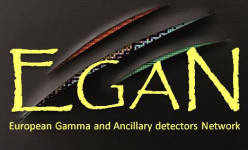Speaker
Angelina Gargano
(INFN NA)
Description
The evolution of nuclear structure for nuclei with an extreme ratio of neutrons to protons is an outstanding problem in modern nuclear structure physics. A relevant role in this study is played by nuclei in the vicinity of doubly closed shells since they offer the opportunity for a direct test of the single-particle properties as well as of the nucleon-nucleon interaction. In this context, a key region is that of exotic 132Sn, which has been the subject of great experimental and theoretical interest during the last decade. In recent years we have studied neutron rich nuclei around 132Sn [1,3] aimed at explaining the available data as well as to make predictions that may be verified in a not too distant future. All these studies have been performed within the framework of the shell model with realistic two-body effective interactions, namely derived microscopically from the free nucleon-nucleon (NN) potential. In this kind of calculations, only the valence nucleons are treated as active particles while the core polarization effects are taken into account perturbatively in the derivation of the effective interaction Veff. More precisely, starting from the CD-Bonn NN potential [4] we construct a low-momentum potential Vlow−k that preserves the deuteron binding energy and scattering phase shifts of the original potential up to a certain cutoff momentum [5]. This Vlow-k is a smooth potential which, summed to the Coulomb force for protons, is used to derive Veff though the folded diagram method [6]. In our calculations we assume 132Sn as a core and take all single-particle or single-hole energies of the shell-model Hamiltonian from the experimental spectra of nuclei with one-valence nucleon, while the two-body matrix elements are derived by the procedure mentioned above. The results obtained for 132Sn neighbors compare well with the available experimental data. Here, we report selected results focusing attention on how some properties change when crossing the N=82 shell closure. In particular, we discuss proton-neutron mixed-symmetry 2+ states in N=80 and 84 nuclei, which allow us to investigate the interplay between identical particles and neutron-proton correlations. References [1] L. Coraggio, A. Covello, A. Gargano , and N. Itaco, Phys. Rev. C 80 061303(R) (2009), and references therein. [2] L. Coraggio, A. Covello, A. Gargano , and N. Itaco, Phys. Rev. C 80 021305 (2009), and references therein. [3] A. Covello, L. Coraggio, A. Gargano , and N. Itaco, J. Phys. : Conf. Ser. 267, 012019 (2011). [4] R. Machleidt, Phys. Rev. C 63, 024001 (2001). [5] S. Bogner, T.T.S. Kuo, L. Coraggio, A. Covello, and N. Itaco, Phys. Rev. C 65, 051301(R) (2002). [6] L. Coraggio, A. Covello, A. Gargano , N. Itaco, and T.T. S. Kuo, Prog. Part. Nucl. Phys. 62, 135 (2009) .
Author
Angelina Gargano
(INFN NA)

